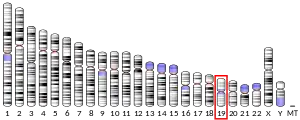| C19orf33 | |||||||||||||||||||||||||||||||||||||||||||||||||||
|---|---|---|---|---|---|---|---|---|---|---|---|---|---|---|---|---|---|---|---|---|---|---|---|---|---|---|---|---|---|---|---|---|---|---|---|---|---|---|---|---|---|---|---|---|---|---|---|---|---|---|---|
| Identifiers | |||||||||||||||||||||||||||||||||||||||||||||||||||
| Aliases | C19orf33, H2RSP, IMUP, IMUP-1, IMUP-2, chromosome 19 open reading frame 33 | ||||||||||||||||||||||||||||||||||||||||||||||||||
| External IDs | HomoloGene: 137645 GeneCards: C19orf33 | ||||||||||||||||||||||||||||||||||||||||||||||||||
| |||||||||||||||||||||||||||||||||||||||||||||||||||
| |||||||||||||||||||||||||||||||||||||||||||||||||||
| |||||||||||||||||||||||||||||||||||||||||||||||||||
| |||||||||||||||||||||||||||||||||||||||||||||||||||
| Wikidata | |||||||||||||||||||||||||||||||||||||||||||||||||||
| |||||||||||||||||||||||||||||||||||||||||||||||||||
Chromosome 19 open reading frame 33 is a protein that in humans is encoded by the C19orf33 gene.[3]
Function
The protein encoded by this gene has been shown to be upregulated in SV40-immortalized fibroblasts as well as in endometrial carcinoma cells. The encoded protein is found primarily in the nucleus. This protein may play a role in placental development and diseases such as pre-eclampsia. Two transcript variants encoding different isoforms have been found for this gene. [provided by RefSeq, Dec 2015].
References
- 1 2 3 GRCh38: Ensembl release 89: ENSG00000167644 - Ensembl, May 2017
- ↑ "Human PubMed Reference:". National Center for Biotechnology Information, U.S. National Library of Medicine.
- ↑ "Entrez Gene: Chromosome 19 open reading frame 33". Retrieved 2018-10-23.
Further reading
- Itoh H, Kataoka H, Yamauchi M, Naganuma S, Akiyama Y, Nuki Y, Shimomura T, Miyazawa K, Kitamura N, Koono M (October 2001). "Identification of hepatocyte growth factor activator inhibitor type 2 (HAI-2)-related small peptide (H2RSP): its nuclear localization and generation of chimeric mRNA transcribed from both HAI-2 and H2RSP genes". Biochem. Biophys. Res. Commun. 288 (2): 390–9. doi:10.1006/bbrc.2001.5767. PMID 11606055.
- Kim JK, An HJ, Kim NK, Ahn JY, Kim KS, Kang YJ, Ko JJ, Oh D, Lee C, Kim SJ, Cha KY (2003). "IMUP-1 and IMUP-2 genes are up-regulated in human ovarian epithelial tumors". Anticancer Res. 23 (6C): 4709–13. PMID 14981917.
- Naganuma S, Itoh H, Uchiyama S, Nagaike K, Tanaka H, Akiyama Y, Chijiiwa K, Kataoka H (March 2006). "Nuclear translocation of H2RSP is impaired in regenerating intestinal epithelial cells of murine colitis model". Virchows Arch. 448 (3): 354–60. doi:10.1007/s00428-005-0064-6. PMID 16189703. S2CID 1817907.
- Betsunoh H, Mukai S, Akiyama Y, Fukushima T, Minamiguchi N, Hasui Y, Osada Y, Kataoka H (April 2007). "Clinical relevance of hepsin and hepatocyte growth factor activator inhibitor type 2 expression in renal cell carcinoma". Cancer Sci. 98 (4): 491–8. doi:10.1111/j.1349-7006.2007.00412.x. PMID 17309599. S2CID 26220332.
- Kim SJ, An HJ, Kim HJ, Jungs HM, Lee S, Ko JJ, Kim IH, Sakuragi N, Kim JK (2008). "Imup-1 and imup-2 overexpression in endometrial carcinoma in Korean and Japanese populations". Anticancer Res. 28 (2A): 865–71. PMID 18507030.
- Jeon SY, Lee HJ, Park JM, Jung HM, Yoo JK, Lee HJ, Lee JS, Cha DH, Kim JK, Kim GJ (May 2010). "Increased immortalization-upregulated protein 2 (IMUP-2) by hypoxia induces apoptosis of the trophoblast and pre-eclampsia". J. Cell. Biochem. 110 (2): 522–30. doi:10.1002/jcb.22568. PMID 20432246. S2CID 42000298.
This article incorporates text from the United States National Library of Medicine, which is in the public domain.
This article is issued from Wikipedia. The text is licensed under Creative Commons - Attribution - Sharealike. Additional terms may apply for the media files.

